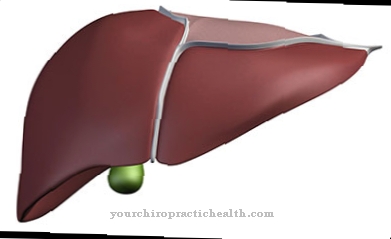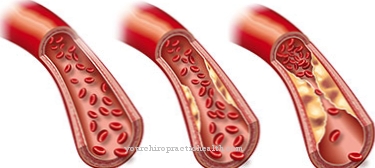The terms Keel breast or Chicken breast denote a clearly visible bulge of the sternum. Only in rare cases does this lead to physical problems, such as poor posture. However, a keel chest is very often a considerable psychological burden for those affected, so that medical attention is necessary in many cases.
What is a keel chest?

© bilderzwerg - stock.adobe.com
In the Keel breast, commonly also called Chicken breast called, it is a deformation of the sternum, which is visibly curved forward. The ribs on the breastbone can also be arched forward.
The main problem with the presence of a quill breast is not medical but psychological. A chicken breast rarely causes physical complaints, but often leads to psychological problems, such as a lack of self-confidence. The psychological burden is not infrequently considerable, especially during puberty, and often requires medical help.
Due to the keel chest, incorrect posture and incorrect movement sequences can occur, which must be supervised by physiotherapy. A keel-shaped protrusion of the sternum occurs more often in boys or men than in women.
causes
Only in exceptional cases will a child with a Keel breast born. Typically, this does not develop until or after the age of ten. The exact causes for the development of a keel breast are still unclear.
It is believed that those affected experience excessive bulging of the sternum because the cartilage on the ribs grows too much and forces the sternum to bulge forward. What exactly is causing the overgrowth of cartilage has yet to be clarified. However, a certain genetic predisposition is likely to play a role.
Doctors have observed that breast deformations can occur more frequently within families. The likelihood of developing a wedge breast is therefore increased if such cases already exist in the family.
Symptoms, ailments & signs
A keel chest is initially noticeable through the characteristic curve of the sternum. The bone protrudes noticeably, while the upper part of the chest may be flattened. This malformation causes accompanying symptoms such as shortness of breath and chest pain. Serious deformations that require independent treatment rarely occur.
Those affected also often complain of impaired lung function, which not only makes breathing difficult, but also reduces physical and mental performance as a result of the insufficient oxygen supply. Those affected have to take regular breaks and are usually no longer able to do sports. Finally, a keel chest can lead to poor posture.
Many sick people are ashamed of the deformity and try to hide it with a stretched posture. This can lead to back pain, among other things. In children, a pronounced keel breast can hinder growth. A chronic lack of oxygen in the organs often leads to further diseases and disorders. These represent a great burden for those affected and cause psychological complaints as a result. The keel chest usually does not develop until after the age of ten, usually beginning with puberty. Congenital malformations are relatively rare.
Diagnosis & course
Diagnosing a Keel breast is posed by looking closely at the patient; this is then called eye diagnosis. The deviation from the norm can be seen directly by the doctor without further examinations. Often an X-ray is taken to establish the diagnosis.
This enables the attending physician to take a closer look at the excessive bulging of the sternum and the cartilage growth defects on the ribs. The X-ray ensures the visual diagnosis. In principle, a quill chest is not a disease, as it usually runs without physical symptoms. In some cases, you may experience chest pain. Sleeping on your stomach is also sometimes found uncomfortable.
Lung function is restricted only in exceptional cases, in which the sternum is severely deformed. Affected people then quickly become out of breath and have to take more breaks than usual during physical activity.
Complications
In most cases, the keel chest does not result in any particular physical limitations or impairment of the patient's health. However, the keel chest can have a very negative effect on the psyche of the person concerned and lead to complaints. As a rule, with this disease, the sternum is arched forward, which leads to greatly reduced aesthetics of the patient.
It is not uncommon for the patient to experience reduced self-esteem or even inferiority complexes. Depression or other psychological stress can also occur as a result of this illness. Furthermore, the keel chest can lead to breathing difficulties, so that those affected suffer from an increased breathing rate. The resilience of the person concerned also decreases and certain activities can no longer be carried out.
Sports activities may also be restricted for the patient. Treatment of the keel breast is only carried out if there are actually symptoms. Parts of the ribs and the sternum can be removed so that the symptoms are reduced. Psychological treatment is often necessary if, for example, teasing or bullying occurs. There are usually no further complications.
When should you go to the doctor?
From a medical point of view, the chest of the keel is not a cause for concern in most cases. The bodily functions of the individual systems of the organism are not impaired by the bulging of the chest. A shortening of the lifespan or disturbances of the heart activity are not given by the deformation either. For a diagnosis and a thorough check-up, a doctor should be seen at the first sign of the development of a chicken breast.
Normally, no further visit to the doctor is necessary because of the keel chest. The exception are patients who suffer from other malformations of the skeletal system in addition to the keel chest. If there is a misalignment, one-sided strain or complaints of the muscular system, a doctor should be consulted. In the event of persistent or regularly recurring tension and a feeling of stiffness, a doctor should be consulted. A general malaise, behavioral problems or changes in personality are indications that the person concerned needs help with.
If there are emotional and mental problems, a visit to the doctor is advisable. Sleep disturbances, inner restlessness, interruptions in the ability to concentrate, mood swings or a depressed appearance are further complaints that should be discussed with a therapist. Support and help are needed in the event of decreased well-being, social withdrawal, partnership and attachment problems, feelings of fear or shame.
Treatment & Therapy
There one Keel breast usually does not cause any health problems, it does not necessarily have to be treated. If the patient does not feel subjectively restricted, then there is no reason for any therapies, since a wedge breast is medically harmless.
If a patient suffers from chest deformation and develops self-esteem problems, psychological or psychotherapeutic help should be offered. Psychotherapeutic care is particularly helpful for patients in whom the wedge breast is not very pronounced and therefore an operation is not recommended due to the risks. For children who are still growing, therapy with a pad, i.e. a bandage, can be very promising and can replace an operation. Such a procedure is tedious and often unpleasant and only promising if the person concerned is motivated.
If the sternum is severely deformed, this can also lead to health problems such as shortness of breath. In addition, those affected very often suffer from their appearance. Children and adolescents with a keel chest in particular are often teased, which also affects their already battered self-confidence. In such cases, surgery is recommended.
During the operation, parts of the breastbone and ribs are removed. After the procedure, further treatment is necessary to improve lung function.
Outlook & forecast
The prognosis of a keel chest is favorable. Normally there are no health problems despite the bulging of the chest. Therefore, it is a visual flaw that in most cases has no disease value. For this reason, the patient is often not treated further. The lifespan is not shortened and physical secondary diseases are unlikely due to the keel chest.
The prognosis worsens if emotional and mental problems arise due to the visual abnormalities. These can contribute to the development and formation of a mental disorder. When making the overall prognosis, well-being and psychological stability must therefore be taken into account. If there is a mental illness, this can have a significant impact on the health of the person concerned. In addition to behavioral problems, changes in personality and a deteriorated quality of life, anxiety disorders or attachment problems can occur.
In rare cases the keel chest leads to shortness of breath or impaired breathing. If the patient decides to have an operation due to physical limitations or mental stress, a significant change and thus optimization of the appearance of the chest can take place. As a rule, there are no further complications during the operation. Nevertheless, every intervention and a change in the human body are associated with risks and side effects.
prevention
Promising measures to prevent a Keel breast there is none, as it is not yet clear what the root cause of the excess costal cartilage is.
Aftercare
The extent to which aftercare is necessary depends on the therapeutic measure chosen and the individual symptoms. In the best case, there is only an optical flaw that does not lead to any physical suffering. Then follow-up care may not be indicated. The patient continues his life after the diagnosis has been received. The situation is different if the keel chest causes a mental suffering.
Then psychotherapy is necessary. In most cases it leads to an increase in self-confidence and can sometimes be done several times. Surgery is only recommended in rare cases. This treatment leads to the expectation that after a while the patient will be able to continue their life without any problems. The keel chest is then gone. A recurrence is just as impossible as everyday complaints.
However, months or years can pass until then. Immediately after an operation, follow-up care consists of breathing and physiotherapy. The body is stabilized using a pressure pad bandage. Improving mobility and strengthening the muscles also play an important role. Follow-up care is usually carried out on an outpatient basis. To assess the success of the therapy, the attending physician will arrange for x-rays. Scheduled follow-up examinations usually take place more and more frequently. They end as soon as the desired result has been achieved.
You can do that yourself
Depending on the severity, a quill chest can cause self-esteem problems and other mental ailments. Those affected can counteract this by being open about the malformation and learning to stand by their body. Psychological or psychotherapeutic help supports this process and especially helps patients for whom an operation is not an option. Further measures are limited to concealing the keel breast. Usually a little more clothing and a conscious adjustment of the posture are sufficient for this.
If the keel chest has already caused a visible malposition, this requires [physiotherapy physiotherapeutic treatment]]. Conscious walking and exercises from yoga or physiotherapy are options for correcting poor posture at home or on the go. However, it usually takes months or even years for the posture to return to normal. In addition, drug therapy is always necessary, as poor posture is usually associated with pain.
The keel chest itself can only be corrected in the long term through an operative procedure. Those affected who would like to have the condition treated surgically should seek a medical examination at an early stage and take the necessary steps.



























